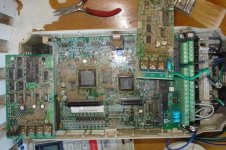waynes
Cast Iron
- Joined
- Mar 5, 2011
- Location
- Trenton, On
I found a large control panel in the local scrap yard and pulled a couple 5hp 460V VFDs. Also got a single phase 6KVA 440-220 V transformer. The VFDs had about a half a cup of water in each one. I pulled the covers off them and sat them in the sun to dry for a couple days. I wired up the cleaner VFD (Saftronics G5 which is a rebadged Yaskawa) to the back fed transformer and with some reprogramming, sure enough it ran.
I really couldn't power up the other one - here's a photo of the not so clean one (YASKAWA F7).

Figuring I had nothing to lose, I started pulling the boards (all 7 of them) until I had it down to the heat sink. I used a paint brush to gently brush all the dried mud - and it was on every board. Put it back together, not expecting too much, and plugged it in. Powered right up! About an hour changing parameters until I stopped getting error codes, and then it was running the motor nicely too. A photo of the cleaned internals:

And a photo of the transformer, the newly cleaned VFD, and the 550 V motor that will soon be going back on the tool and cutter grinder now that I have a power source.

The back fed transformer is putting out right around 500 V. The max input setting on both VFDs happens to be 510V, so I figure it will work nicely for feeding 550 V motors that are common on older Canadian machine tools, and you can set the max voltage down to 440 for American made equipment. Now I just need to find (or build) another 220-440V transformer to feed the other VFD. Oh - just about forgot the price. $27 for the transformer, 5 for the cleaner VFD, and nothing for the dirty but newer and nicer one!
Wayne
I really couldn't power up the other one - here's a photo of the not so clean one (YASKAWA F7).

Figuring I had nothing to lose, I started pulling the boards (all 7 of them) until I had it down to the heat sink. I used a paint brush to gently brush all the dried mud - and it was on every board. Put it back together, not expecting too much, and plugged it in. Powered right up! About an hour changing parameters until I stopped getting error codes, and then it was running the motor nicely too. A photo of the cleaned internals:

And a photo of the transformer, the newly cleaned VFD, and the 550 V motor that will soon be going back on the tool and cutter grinder now that I have a power source.

The back fed transformer is putting out right around 500 V. The max input setting on both VFDs happens to be 510V, so I figure it will work nicely for feeding 550 V motors that are common on older Canadian machine tools, and you can set the max voltage down to 440 for American made equipment. Now I just need to find (or build) another 220-440V transformer to feed the other VFD. Oh - just about forgot the price. $27 for the transformer, 5 for the cleaner VFD, and nothing for the dirty but newer and nicer one!
Wayne

